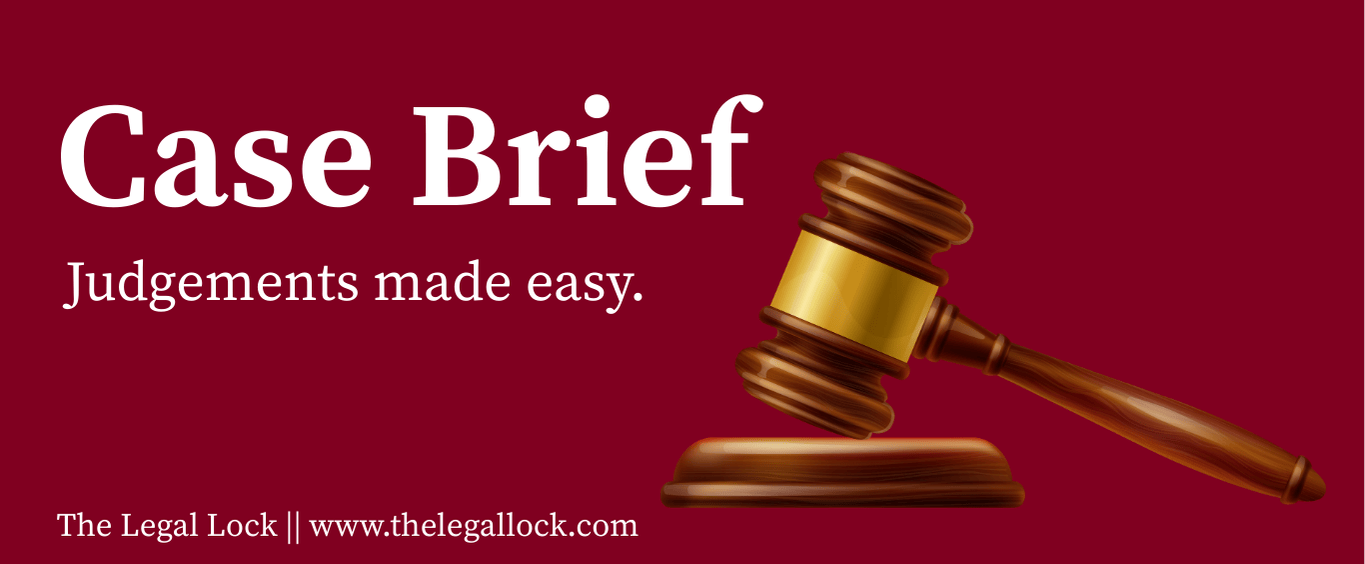CASE BRIEF: Swiss Ribbons Pvt. Ltd. & Anr vs. Union of India & Ors.

| CASE NAME | Swiss Ribbons Pvt. Ltd. & Anr vs. Union of India & Ors. |
| CITATION | Writ Petition (Civil) No. 99 Of 2018 |
| COURT | In the Supreme Court of India. |
| Bench | R.F. Nariman, Navin Sinha |
| Date of Decision | 25 January, 2019 |
Introduction
The case of Swiss Ribbons Pvt. Ltd. & Anr. vs. Union of India & Ors stands as a landmark decision in India’s evolving insolvency jurisprudence. Delivered by the Supreme Court of India, this ruling examined the constitutional validity of key provisions of the Insolvency and Bankruptcy Code (IBC), 2016, particularly the distinction between financial and operational creditors, the role of resolution professionals, and the overall fairness of the insolvency resolution framework.
The challenge arose from concerns over the classification of creditors, arguing that the IBC created an arbitrary distinction that disadvantaged operational creditors in the corporate insolvency resolution process (CIRP). The petitioners contended that the framework disproportionately empowered financial creditors, thereby undermining equitable treatment. The case also scrutinized the independence of the National Company Law Tribunal (NCLT) and the National Company Law Appellate Tribunal (NCLAT), along with procedural safeguards for debtors.
By upholding the IBC’s framework, the Supreme Court reinforced the legislative intent behind the Code—ensuring economic revival and maximizing asset value while maintaining procedural integrity. This ruling not only reaffirmed the robustness of India’s insolvency regime but also highlighted the judiciary’s role in balancing efficiency with fairness in corporate restructuring.
FACTS
The petitioners, Swiss Ribbons Pvt. Ltd., and others challenged the constitutional validity of various provisions of the Insolvency and Bankruptcy Code (IBC), 2016, before the Supreme Court of India. The dispute centered on the differentiation between financial and operational creditors, the procedural framework governing insolvency resolution, and the overall fairness of the corporate insolvency resolution process (CIRP).
The IBC was enacted to streamline insolvency proceedings, ensuring a time-bound resolution of distressed assets while maximizing their value. However, the petitioners contended that the Code’s classification of creditors was arbitrary and discriminatory. According to them, operational creditors who supply goods and services were unfairly excluded from decision-making within the Committee of Creditors (CoC), which was composed exclusively of financial creditors such as banks and institutional lenders. The petitioners argued that such a classification violated Article 14 of the Constitution of India by denying operational creditors an equitable say in the resolution process.
Another critical issue pertained to the appointment and functioning of the National Company Law Tribunal (NCLT) and the National Company Law Appellate Tribunal (NCLAT). The petitioners contended that certain members of these tribunals had been appointed contrary to judicial directives, raising concerns over the legitimacy of their rulings. Further, they argued that the tribunals, instead of being administratively supported by the Ministry of Law and Justice, were functioning under the Ministry of Corporate Affairs, which could lead to potential conflicts of interest.
Additionally, the petitioners raised concerns regarding the role of Resolution Professionals (RPs) under the IBC. They argued that RPs wielded excessive power in insolvency proceedings without adequate judicial oversight, potentially compromising the rights of corporate debtors. The challenge also extended to the mechanism for withdrawal of CIRP under Section 12A of the IBC, which required the approval of 90% of the CoC, making it disproportionately difficult for corporate debtors to settle disputes outside the insolvency framework.
Despite these contentions, the Union of India defended the IBC, asserting that the differentiation between financial and operational creditors was based on rational economic considerations. The government maintained that financial creditors, being lenders with long-term stakes in distressed companies, were better positioned to assess resolution plans, whereas operational creditors primarily sought immediate payment for goods and services.
The case thus raised fundamental questions about the IBC’s structure, procedural fairness, and the balance between efficiency and equitable treatment of stakeholders in India’s insolvency regime.
ISSUES
- Whether the classification of creditors under the Insolvency and Bankruptcy Code (IBC), 2016, particularly the distinction between financial and operational creditors, violates Article 14 of the Constitution of India by denying operational creditors equitable participation in the insolvency resolution process.
- Whether the administrative framework and appointment process of members in the National Company Law Tribunal (NCLT) and National Company Law Appellate Tribunal (NCLAT) were in compliance with judicial directives, ensuring independence and procedural fairness.
- Whether the insolvency resolution process, including the role of Resolution Professionals (RPs) and the withdrawal mechanism under Section 12A of the IBC, met constitutional and statutory standards of fairness, transparency, and due process.
ARGUMENTS FROM BOTH SIDES
Arguments by the petitioners
- The petitioners contended that the distinction between financial and operational creditors under the IBC was arbitrary and violative of Article 14 of the Constitution. They argued that both categories of creditors contributed to the financial health of a corporate debtor, and denying operational creditors voting rights in the Committee of Creditors (CoC) was discriminatory.
- The petitioners argued that operational creditors were placed at a disadvantage as they had no meaningful role in approving or rejecting resolution plans. Unlike financial creditors, operational creditors were often left with minimal recoveries, undermining the objective of equitable distribution under the insolvency framework.
- The petitioners claimed that the administrative control of the National Company Law Tribunal (NCLT) and the National Company Law Appellate Tribunal (NCLAT) under the Ministry of Corporate Affairs compromised their independence. They asserted that, as per judicial directives, tribunals handling insolvency matters should function under the Ministry of Law and Justice to ensure impartiality.
- The petitioners argued that RPs wielded disproportionate power in the insolvency process without sufficient judicial oversight. They contended that the role of RPs in verifying claims, managing assets, and overseeing resolutions should be subject to stricter checks to prevent abuse and ensure fairness in proceedings.
Arguments by the Respondents
- Rational Basis for Creditor Classification: The respondents defended the distinction between financial and operational creditors, arguing that financial creditors had a deeper financial stake in a corporate debtor’s viability. They contended that financial creditors were better suited to assess resolution plans, given their expertise in credit evaluation and restructuring.
- The respondents asserted that the Supreme Court should not interfere with the CoC’s commercial decisions. They maintained that the IBC prioritized timely resolution over prolonged litigation, and judicial intervention in financial creditors’ decision-making process would undermine the insolvency framework’s efficiency.
- The respondents refuted allegations regarding the independence of NCLT and NCLAT, stating that all tribunal appointments had been made in accordance with constitutional principles and prior Supreme Court judgments. They argued that administrative oversight by the Ministry of Corporate Affairs did not compromise judicial independence.
DECISION
In Swiss Ribbons Pvt. Ltd. & Anr. vs. Union of India & Ors., the Supreme Court of India examined the constitutional validity of various provisions of the Insolvency and Bankruptcy Code, 2016 (IBC). The petitioners challenged the differential treatment of financial and operational creditors, the structure of the National Company Law Tribunal (NCLT) and National Company Law Appellate Tribunal (NCLAT), and the exclusion of promoters from resolution plans under Section 29A.
The Court upheld the IBC’s framework, ruling that the classification between financial and operational creditors was based on intelligible differentia, ensuring an efficient insolvency resolution process. It held that financial creditors, given their expertise in loan structuring and risk assessment, were rightly placed in the Committee of Creditors (CoC) to oversee resolution plans. Further, the Court rejected claims that the appointment of NCLT and NCLAT members was unconstitutional, confirming compliance with established legal precedents.
Addressing Section 29A, the Court emphasized the necessity of barring defaulting promoters to prevent misuse of insolvency proceedings and ensure a fair resolution process. The judgment reinforced the economic objectives of the IBC, affirming its role in maximizing asset value, ensuring credit availability, and maintaining financial discipline.
By dismissing the petitions, the Supreme Court upheld the IBC’s constitutional legitimacy, reinforcing its pivotal role in India’s corporate insolvency landscape.
CONCLUSION
The Supreme Court’s decision in Swiss Ribbons Pvt. Ltd. & Anr. vs. Union of India & Ors underscores the constitutional soundness of the Insolvency and Bankruptcy Code (IBC), 2016, reinforcing its role in streamlining corporate insolvency while maintaining procedural integrity.
A key contention in the case was the differential treatment of financial and operational creditors. The Court upheld this distinction, recognizing financial creditors’ role in credit assessment and risk management, which justifies their control over the Corporate Insolvency Resolution Process (CIRP). It dismissed claims of discrimination, affirming that such classification is necessary for efficient resolution.
Additionally, the petitioners challenged the appointment process of NCLT and NCLAT members and the exclusion of defaulting promoters under Section 29A. The Court found no procedural irregularities in tribunal appointments, confirming their legitimacy. It also upheld the restriction on defaulting promoters, emphasizing that preventing those responsible for financial distress from regaining control aligns with the IBC’s objective of maximizing asset value and ensuring creditor confidence.
By validating the IBC’s provisions, the judgment reaffirmed the Supreme Court’s commitment to balancing economic pragmatism with legal principles. It serves as a precedent in safeguarding the IBC’s framework, ensuring that the insolvency process remains transparent, fair, and efficient. The ruling reinforces the judiciary’s role in maintaining statutory compliance while enabling effective corporate restructuring.






